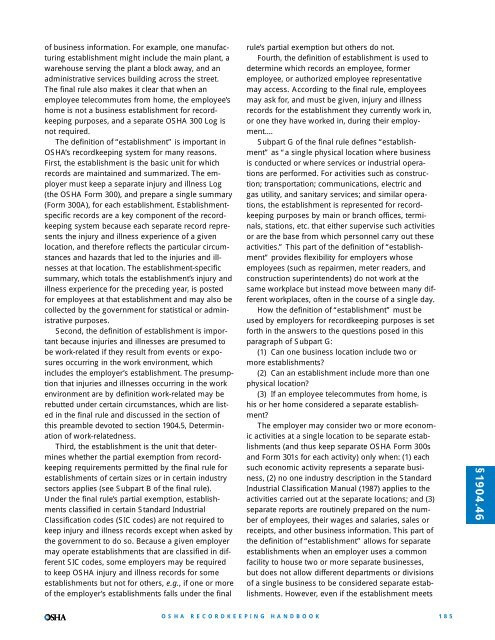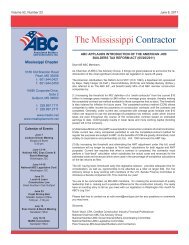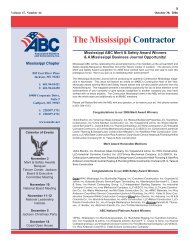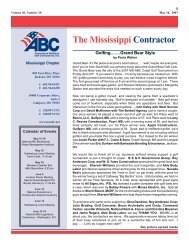allows him or her to independently perform, or bedelegated the responsibility to perform, the activitiesdescribed by this regulation.You.“You” means an employer as defined in Section 3 ofthe Occupational Safety and Health Act of 1970 (29U.S.C. 652).PREAMBLE DISCUSSION: Section 1904.46(66 FR 6071-6081, Jan. 19, 2001)The following are selected excerpts from the preamble to the Occupational Injury and Illness Recording andReporting Requirements, the <strong>Recordkeeping</strong> rule (66 FR 5916, 29 CFR Parts 1904 and 1952). These excerptsrepresent some of the key discussions related to the final rule (66 FR 6122, 29 CFR Parts 1904 and 1952).§1904.46Subpart G – DefinitionsThe Definitions section of the final rule contains definitionsfor five terms: “the Act,” “establishment,”“health care professional,” “injury and illness,” and“you.” To reduce the need for readers to move backand forth from the regulatory text to the Definitionssection of this preamble, all other definitions used inthe final rule are defined in the regulatory text as theterm is used. <strong>OSHA</strong> defines the five terms in this sectionhere because they are used in several places inthe regulatory text.The ActThe Occupational Safety and Health Act of 1970 (the“OSH Act”) is defined because the term is used inmany places in the regulatory text. The final rule’sdefinition is essentially identical to the definition inthe proposal. <strong>OSHA</strong> received no comments on thisdefinition. The definition of “the Act” follows:The Act means the Occupational Safety andHealth Act of 1970 (84 Stat. 1590 et seq., 29 U.S. 651et seq.), as amended. The definitions contained insection (3) of the Act and related interpretations shallbe applicable to such terms when used in this Part1904.Employee...In the final rule, <strong>OSHA</strong> has decided that it is notnecessary to define “employee” because the term isdefined in section 3 of the Act and is used in this rulein accordance with that definition.Employer...Because the final rule uses the term “employer”just as it is defined in the Act, no separate definitionis included in the final rule.EstablishmentThe final rule defines an establishment as a singlephysical location where business is conducted orwhere services or industrial operations are performed.For activities where employees do not workat a single physical location, such as construction;transportation; communications, electric, gas andsanitary services; and similar operations, the establishmentis represented by main or branch offices,terminals, stations, etc. that either supervise suchactivities or are the base from which personnel carryout these activities.The final rule also addresses whether one businesslocation can include two or more establishments.Normally, one business location has only oneestablishment. However, under limited conditions,the employer may consider two or more separatebusinesses that share a single location to be separateestablishments for recordkeeping purposes. Anemployer may divide one location into two or moreestablishments only when: each of the proposedestablishments represents a distinctly separate business;each business is engaged in a different economicactivity; no one industry description in theStandard Industrial Classification Manual (1987)applies to the joint activities of the proposed establishments;and separate reports are routinely preparedfor each establishment on the number ofemployees, their wages and salaries, sales or receipts,and other business information. For example,if an employer operates a construction company atthe same location as a lumber yard, the employermay consider each business to be a separate establishment.The final rule also deals with the opposite situation,and explains when an establishment includesmore than one physical location. An employer maycombine two or more physical locations into a singleestablishment only when the employer operates thelocations as a single business operation under commonmanagement; the locations are all located inclose proximity to each other; and the employerkeeps one set of business records for the locations,such as records on the number of employees, theirwages and salaries, sales or receipts, and other kinds184<strong>OSHA</strong> RECORDKEEPINGHANDBOOK
of business information. For example, one manufacturingestablishment might include the main plant, awarehouse serving the plant a block away, and anadministrative services building across the street.The final rule also makes it clear that when anemployee telecommutes from home, the employee’shome is not a business establishment for recordkeepingpurposes, and a separate <strong>OSHA</strong> 300 Log isnot required.The definition of “establishment” is important in<strong>OSHA</strong>’s recordkeeping system for many reasons.First, the establishment is the basic unit for whichrecords are maintained and summarized. The employermust keep a separate injury and illness Log(the <strong>OSHA</strong> Form 300), and prepare a single summary(Form 300A), for each establishment. Establishmentspecificrecords are a key component of the recordkeepingsystem because each separate record representsthe injury and illness experience of a givenlocation, and therefore reflects the particular circumstancesand hazards that led to the injuries and illnessesat that location. The establishment-specificsummary, which totals the establishment’s injury andillness experience for the preceding year, is postedfor employees at that establishment and may also becollected by the government for statistical or administrativepurposes.Second, the definition of establishment is importantbecause injuries and illnesses are presumed tobe work-related if they result from events or exposuresoccurring in the work environment, whichincludes the employer’s establishment. The presumptionthat injuries and illnesses occurring in the workenvironment are by definition work-related may berebutted under certain circumstances, which are listedin the final rule and discussed in the section ofthis preamble devoted to section 1904.5, Determinationof work-relatedness.Third, the establishment is the unit that determineswhether the partial exemption from recordkeepingrequirements permitted by the final rule forestablishments of certain sizes or in certain industrysectors applies (see Subpart B of the final rule).Under the final rule’s partial exemption, establishmentsclassified in certain Standard IndustrialClassification codes (SIC codes) are not required tokeep injury and illness records except when asked bythe government to do so. Because a given employermay operate establishments that are classified in differentSIC codes, some employers may be requiredto keep <strong>OSHA</strong> injury and illness records for someestablishments but not for others, e.g., if one or moreof the employer’s establishments falls under the finalrule’s partial exemption but others do not.Fourth, the definition of establishment is used todetermine which records an employee, formeremployee, or authorized employee representativemay access. According to the final rule, employeesmay ask for, and must be given, injury and illnessrecords for the establishment they currently work in,or one they have worked in, during their employment....Subpart G of the final rule defines “establishment”as “a single physical location where businessis conducted or where services or industrial operationsare performed. For activities such as construction;transportation; communications, electric andgas utility, and sanitary services; and similar operations,the establishment is represented for recordkeepingpurposes by main or branch offices, terminals,stations, etc. that either supervise such activitiesor are the base from which personnel carry out theseactivities.” This part of the definition of “establishment”provides flexibility for employers whoseemployees (such as repairmen, meter readers, andconstruction superintendents) do not work at thesame workplace but instead move between many differentworkplaces, often in the course of a single day.How the definition of “establishment” must beused by employers for recordkeeping purposes is setforth in the answers to the questions posed in thisparagraph of Subpart G:(1) Can one business location include two ormore establishments?(2) Can an establishment include more than onephysical location?(3) If an employee telecommutes from home, ishis or her home considered a separate establishment?The employer may consider two or more economicactivities at a single location to be separate establishments(and thus keep separate <strong>OSHA</strong> Form 300sand Form 301s for each activity) only when: (1) eachsuch economic activity represents a separate business,(2) no one industry description in the StandardIndustrial Classification Manual (1987) applies to theactivities carried out at the separate locations; and (3)separate reports are routinely prepared on the numberof employees, their wages and salaries, sales orreceipts, and other business information. This part ofthe definition of “establishment” allows for separateestablishments when an employer uses a commonfacility to house two or more separate businesses,but does not allow different departments or divisionsof a single business to be considered separate establishments.However, even if the establishment meets§1904.46<strong>OSHA</strong> RECORDKEEPINGHANDBOOK185
- Page 1 and 2:
www.osha.govOSHARecordkeepingHandbo
- Page 3 and 4:
OSHARecordkeeping HandbookThe Regul
- Page 5 and 6:
ContentsRecordkeeping HandbookRoadm
- Page 7 and 8:
Section 1904.40Providing records to
- Page 9 and 10:
Section 1904.0Purpose(66 FR 6122, J
- Page 11 and 12:
Section 1904.1Partial exemption for
- Page 13 and 14:
Section 1904.2Partial exemption for
- Page 15 and 16:
employees, to OSHA within 8 hours (
- Page 17 and 18:
Partial Exemptions for Employers Un
- Page 19 and 20:
Section 1904.4Recording criteria(66
- Page 21 and 22:
Section 1904.5Determination of work
- Page 23 and 24:
(b)(7) How do I decide if a case is
- Page 25 and 26:
well, including providing informati
- Page 27 and 28:
This exception, which responds to i
- Page 29 and 30:
or she is in the work environment a
- Page 31 and 32:
have occurred but for the occupatio
- Page 33 and 34:
considered work-related. If an empl
- Page 35 and 36:
Question 5-12. Is work-related stre
- Page 37 and 38:
• The doctor described the illnes
- Page 39 and 40:
Scenario 7:• A site hired numerou
- Page 41 and 42:
Letter of interpretation related to
- Page 43 and 44:
These principles should be applied
- Page 45 and 46:
The problem with the response is tw
- Page 47 and 48:
Section 1904.6Determination of new
- Page 49 and 50:
the Guidelines stated that “the a
- Page 51 and 52:
estricted work. If the case is a pr
- Page 53 and 54:
• The doctor also prescribed the
- Page 55 and 56:
• The employees were under the di
- Page 57 and 58:
Section 1904.7General recording cri
- Page 59 and 60:
(iii) Do I have to record restricte
- Page 61 and 62:
of the length of time the employee
- Page 63 and 64:
then result in days away from work
- Page 65 and 66:
A partial day of work is recorded a
- Page 67 and 68:
In all other respects, the final ru
- Page 69 and 70:
ments. The Agency believes that the
- Page 71 and 72:
e recorded because it will require
- Page 73 and 74:
However, episodes of fainting from
- Page 75 and 76:
care professional, he or she may al
- Page 77 and 78:
“Other simple means” of removin
- Page 79 and 80:
For purposes of OSHA recordkeeping
- Page 81 and 82:
• When answering the doctor’s q
- Page 83 and 84:
Response: In the recordkeeping regu
- Page 85 and 86:
Letter of interpretation related to
- Page 87 and 88:
Section 1904.8Recording criteria fo
- Page 89 and 90:
caused by contaminated needles and
- Page 91 and 92:
Section 1904.9Recording criteria fo
- Page 93 and 94:
Section 1904.10Recording criteria f
- Page 95 and 96:
hearing loss case that is not relat
- Page 97 and 98:
average of 10 decibels or more at 2
- Page 99 and 100:
argued that because the function of
- Page 101 and 102:
occurs, and where hearing loss can
- Page 103 and 104:
cases in their workplace via analys
- Page 105 and 106:
March 4, 2004Mr. Carl O. Sall, CIHD
- Page 107 and 108:
When the professional evaluating th
- Page 109 and 110:
(2) May I line-out or erase a recor
- Page 111 and 112:
Section 1904.12Recording criteria f
- Page 113 and 114:
These new statistics would add only
- Page 115 and 116:
Sections 1904.13 - 1904.28 Reserved
- Page 117 and 118:
two lines of the OSHA 300 Log to de
- Page 119 and 120:
which replace the OSHA 200 and 101
- Page 121 and 122:
different types of occupational ill
- Page 123 and 124:
OSHA 301 form. These data are usefu
- Page 125 and 126:
LETTERS OF INTERPRETATION: Section
- Page 127 and 128:
Question 2: Under 29 CFR Section 19
- Page 129 and 130:
and has adopted language in the fin
- Page 131 and 132:
Section 1904.31Covered employees(66
- Page 133 and 134:
label assigned to a worker is immat
- Page 135 and 136:
These workers should be evaluated j
- Page 137 and 138:
Response: A case is work-related if
- Page 139 and 140:
Response: Section 1904.31 states th
- Page 141 and 142: Thank you for your interest in occu
- Page 143 and 144: year covered by the summary. The su
- Page 145 and 146: 2. Number of employees and hours wo
- Page 147 and 148: LETTERS OF INTERPRETATION: Section
- Page 149 and 150: Section 1904.33Retention and updati
- Page 151 and 152: June 23, 2003Mr. Edwin G. Foulke, J
- Page 153 and 154: Section 1904.34Change in business o
- Page 155 and 156: PREAMBLE DISCUSSION: Section 1904.3
- Page 157 and 158: Incident Report (Forms 300 and 301,
- Page 159 and 160: workers’ compensation claim. See
- Page 161 and 162: LETTERS OF INTERPRETATION: Section
- Page 163 and 164: Letter of interpretation related to
- Page 165 and 166: Question 3: Using the facts in Ques
- Page 167 and 168: Section 1904.37State recordkeeping
- Page 169 and 170: tion, require employers to report f
- Page 171 and 172: (5) If I receive a variance, may th
- Page 173 and 174: Section 1904.39Reporting fatalities
- Page 175 and 176: gation. Therefore, the final rule d
- Page 177 and 178: Section 1904.40Providing records to
- Page 179 and 180: ness. The government inspector may
- Page 181 and 182: Response: The controlling employer
- Page 183 and 184: FREQUENTLY ASKED QUESTIONS: Section
- Page 185 and 186: OSHA and the BLS have worked togeth
- Page 187 and 188: provide copies of the retained reco
- Page 189 and 190: FREQUENTLY ASKED QUESTIONS: Section
- Page 191: Section 1904.46Definitions(66 FR 61
- Page 195 and 196: inconvenience associated with keepi
- Page 197 and 198: skin disease, respiratory disorder,
- Page 199 and 200: Question 2: Under 29 CFR Section 19
- Page 201: www.osha.gov







